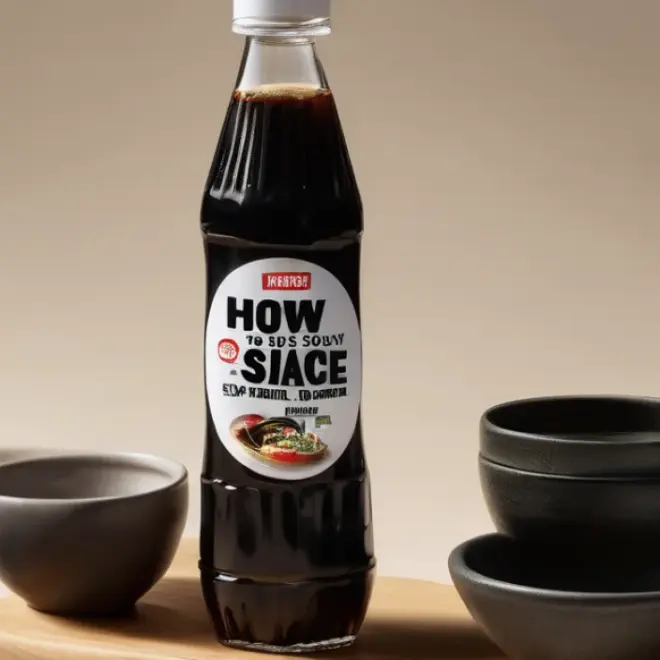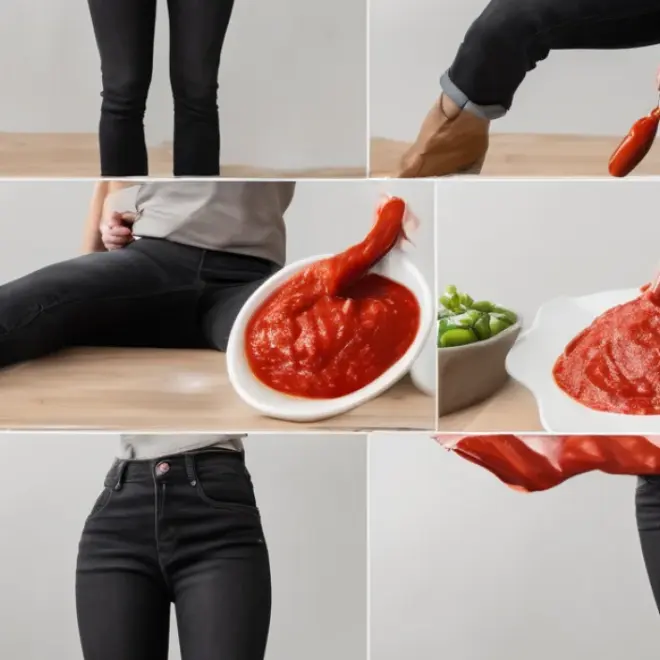Quick Summary: Easily remove tea stains from your jeans with simple household items like dish soap and cold water. Act fast for best results, and gently blot, don’t rub, to preserve your denim and lift the stain effectively.
How To Remove Tea From Jeans: Effortless Stain Solution
Ugh, that dreaded tea stain on your favorite pair of jeans! It happens to the best of us, whether it’s a morning brew gone rogue or an afternoon pick-me-up that missed its mark. Tea, especially dark varieties like black tea, can leave stubborn marks that seem impossible to tackle, leaving you wondering if your beloved denim is ruined. But don’t worry, getting tea out of jeans is often much simpler than you think. With a few common household items and a little patience, you can restore your jeans to their stain-free glory.
This guide will walk you through the easiest and most effective ways to banish those tea stains, ensuring your jeans look as good as new. We’ll cover what to do immediately, what supplies you’ll need, and step-by-step instructions that are clear and fuss-free. Get ready to say goodbye to tea stains for good!
Why Do Tea Stains Appear on Jeans?
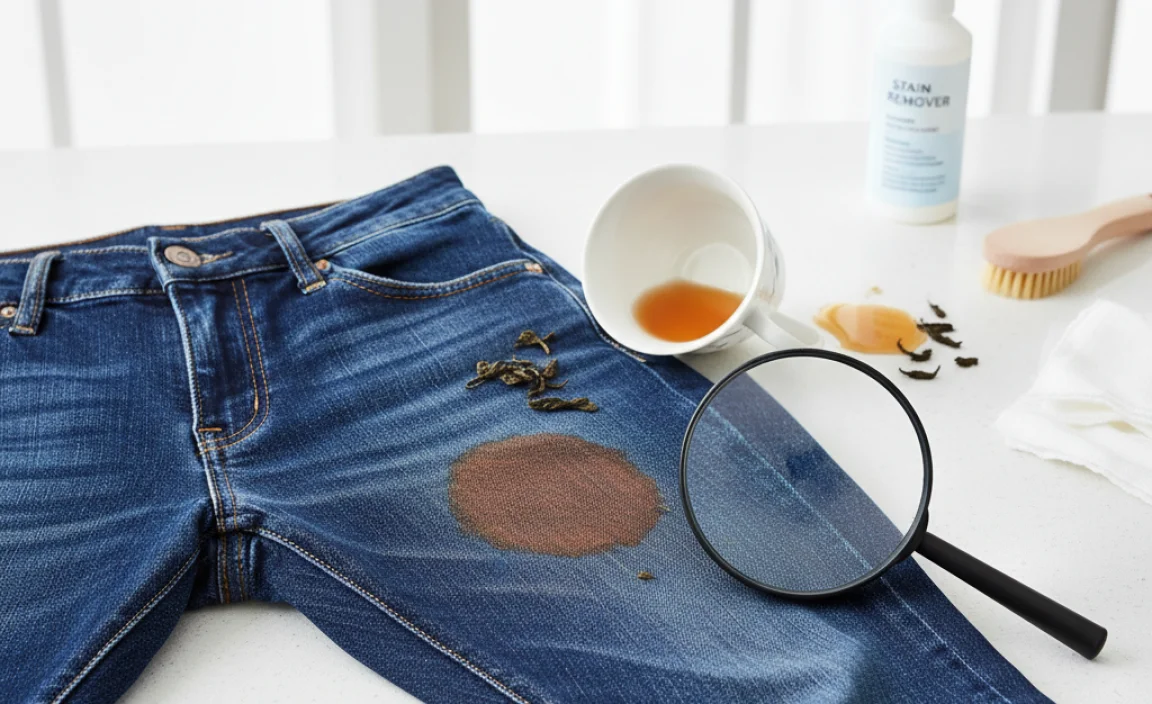
Tea is a common beverage enjoyed by millions worldwide. Its popularity stems from its diverse flavors and perceived health benefits. However, teas, particularly black tea, contain tannins. Tannins are natural compounds found in many plants, fruits, and beverages, including tea, coffee, and wine. These compounds are responsible for the color and often the slightly bitter or astringent taste of tea.
When tea spills onto fabric like denim, the tannins in the tea can bond with the fibers. Denim, with its tightly woven structure, can sometimes hold onto these pigments quite effectively, especially if the spill is left to sit. The longer the tea remains on the jeans, the deeper it can penetrate the fabric fibers, making the stain more challenging to remove. The heat of the tea can also set the stain, though cold is generally better for initial treatment. Understanding this basic science helps us approach stain removal more effectively.
What You’ll Need: Your Stain-Fighting Arsenal
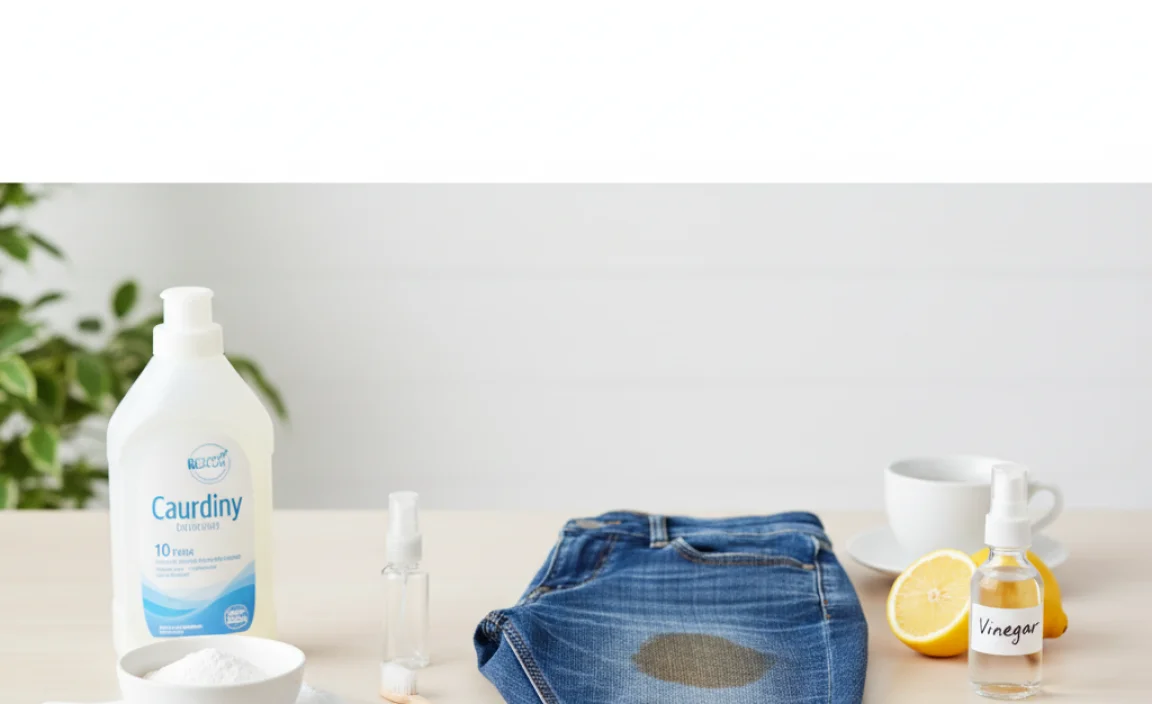
Before we dive into the steps, let’s gather the essentials. The good news is you probably already have most of these items in your home. Having them ready will make the stain removal process smooth and efficient.
Essential Supplies:
- Cold water
- Mild liquid dish soap (like Dawn or a gentle, clear brand)
- Clean white cloths or paper towels
- An old toothbrush or soft-bristled brush (optional)
- White vinegar (optional, for tougher stains)
- Baking soda (optional, for deeper stains)
- A bowl or basin
Why These Items Work:
Cold Water: It’s crucial to start with cold water. Hot water can actually set protein-based stains and some dye stains, making them harder to remove. Cold water helps to loosen the stain without making it permanent.
Mild Liquid Dish Soap: Dish soap is designed to cut through grease and grime, and it’s also remarkably effective at lifting many types of stains, including those from beverages like tea. Look for a clear or light-colored liquid dish soap to avoid transferring any color to your jeans.
White Vinegar: This is a mild acid that can help break down the tannins in tea, making them easier to lift from the fabric. It’s also a natural deodorizer and disinfectant.
Baking Soda: A gentle abrasive and an alkalizing agent, baking soda can help lift stains and neutralize odors. It can also form a paste that helps to draw out the stain.
White Cloths/Paper Towels: These are for blotting and rinsing. Using white materials ensures that no dye transfers from the cleaning cloth to your jeans.
Step-by-Step Guide: Removing Tea Stains from Jeans

Treating a tea stain on your jeans is a straightforward process. The key is to act quickly and follow these gentle yet effective steps.
Step 1: Act Fast – Blot the Spill
As soon as you notice the spill, grab a clean white cloth or paper towel and gently blot the affected area. Do NOT rub. Rubbing can spread the stain and push it deeper into the denim fibers. Your goal here is to absorb as much of the liquid tea as possible before it has a chance to set.
Step 2: Rinse with Cold Water
Turn the jeans inside out and hold the stained area under cold running water. Let the water run through the back of the stain. This helps push the tea out of the fibers from the source, rather than further into the fabric. Continue rinsing for a minute or two.
Step 3: Apply Mild Dish Soap
Gently rub a small amount of mild liquid dish soap directly into the stained area. You can use your fingers or a soft-bristled brush or old toothbrush for this. Work the soap into the fabric delicately, ensuring it covers the entire stained portion. Let it sit for about 5-10 minutes.
Step 4: Rinse Again
Rinse the area thoroughly with cold water. You should start to see the stain fading. If the stain is still visible, repeat Step 3. You can also create a paste of baking soda and water and apply it to the stain, letting it sit for another 15-30 minutes before rinsing.
Step 5: Soak for Tougher Stains (Optional)
If the stain persists, it’s time for a soak. Fill a basin or sink with cold water and add about a quarter cup of white vinegar. Submerge the stained part of the jeans and let them soak for at least 30 minutes, or even a couple of hours for stubborn stains. The vinegar helps to break down the tannins.
Step 6: Gentle Wash
After soaking (or after Step 4 if the stain is gone), wash your jeans as you normally would, but use cold water. It’s best to wash them alone or with other dark-colored items to prevent dye transfer. If possible, air dry them at first. This is crucial because machine dryers can set any remaining stain permanently, making it nearly impossible to remove later.
Step 7: Check Before Drying
Once the wash cycle is complete, inspect the stained area carefully. If the stain is completely gone, you can proceed to dry your jeans as usual. If you can still see any trace of the stain, do NOT put them in the dryer. Repeat the stain removal process from Step 3. You might need to try a commercial stain remover specifically for denim if home remedies don’t completely work.
Advanced Tips for Stubborn Tea Stains

While the steps above are usually effective, some tea stains can be more persistent. Here are a few extra tricks to try:
Using a Baking Soda Paste Boost
For stains that don’t seem to budge, a thicker baking soda paste can be more effective. Mix baking soda with just enough cold water to form a thick paste. Apply this paste generously over the stain, ensuring it’s completely covered. Let it sit for at least 30 minutes, or even an hour. You can gently work it into the fabric with a soft brush. Then, rinse thoroughly with cold water.
The Power of Hydrogen Peroxide (with caution!)
For light-colored or white jeans, a diluted solution of hydrogen peroxide can be a powerful stain remover. Mix one part hydrogen peroxide with two parts cold water. Apply with a clean cloth, blotting the stain. Let it work for a few minutes, then rinse thoroughly. Important: Always test this on an inconspicuous area of the jeans first, as hydrogen peroxide can lighten or bleach fabric. It’s generally not recommended for dark or colored denim.
Commercial Stain Removers
If you’ve tried several home remedies without complete success, consider using a commercial stain remover. Look for products specifically designed for tannin or beverage stains. Follow the product instructions carefully, and always do a spot test on a hidden area of the jeans first.
According to the Environmental Protection Agency (EPA), choosing eco-friendly laundry practices, like using cold water, also saves energy and reduces your environmental footprint. Combining these with effective stain removal means your jeans look great and you’re making a responsible choice.
Understanding Different Tea Types and Denim Colors
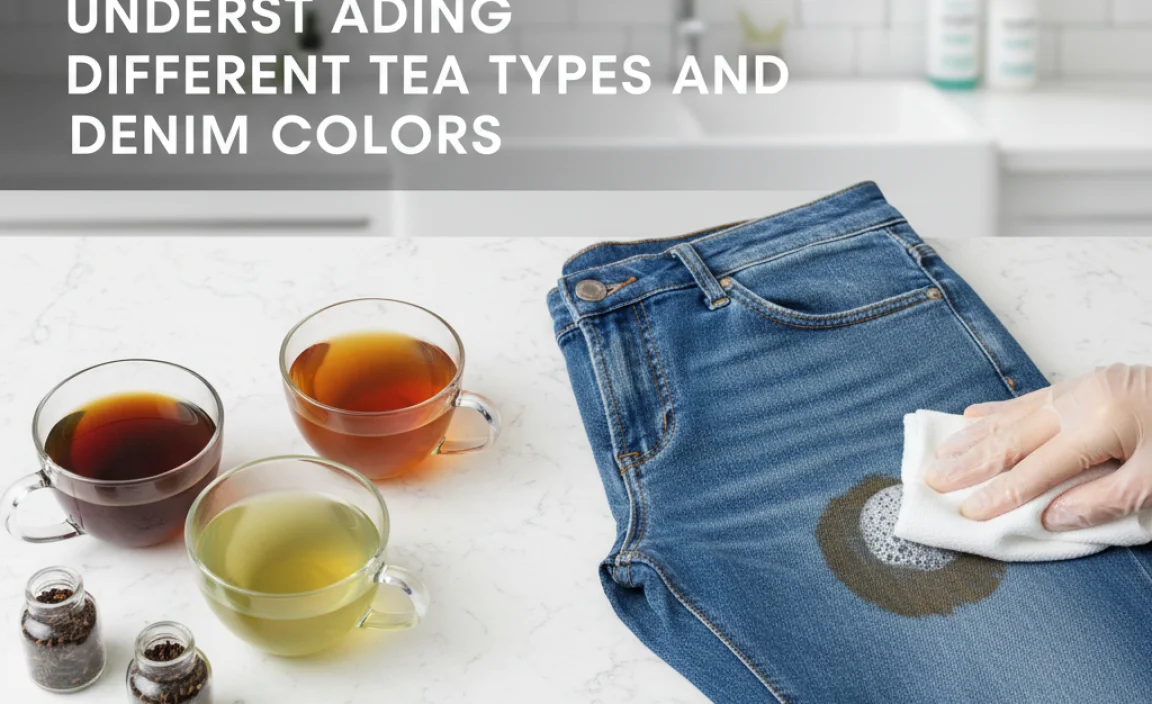
The type of tea and the color of your jeans can influence how difficult a stain is to remove.
Tea Types and Stain Potential
Black Tea: This is typically the most problematic due to its high tannin content and dark pigment. It leaves a strong, often reddish-brown stain.
- Action: Blot immediately, rinse with cold water, and use dish soap or a vinegar soak.
Green Tea: Generally lighter in color and contains fewer harsh tannins than black tea. It can still stain, often appearing as a lighter brown or yellowish mark.
- Action: Cold water rinse and mild soap are usually sufficient.
Herbal Teas (e.g., Berry, Hibiscus): These can be a wild card. While often lighter, some, especially those made with dark berries or flowers, can contain strong pigments that stain similarly to black tea.
- Action: Treat as you would black tea, especially if the fresh tea is deeply colored.
Denim Colors and Stain Visibility
Dark Wash/Black Denim: Tea stains can be less noticeable at first because the dark color can camouflage the mark. However, once the stain sets, it can lead to faded or discolored patches that are very apparent when you look closely, especially after washing.
- Challenge: Stains might become visible after washing if not fully removed, appearing as lighter spots.
- Solution: Gentle, targeted treatment is key. Avoid harsh scrubbing that could damage the dye.
Light Wash/White Denim: Tea stains are most visible on light or white denim, making them appear more urgent to treat. The light fibers readily absorb the pigment.
- Challenge: Stains are highly apparent and can be stubborn.
- Solution: Act fast. White denim offers more options for stain removal agents like diluted hydrogen peroxide (test first!) but can also show lingering yellow or brown tints if not fully treated.
Colored Denim: Similar to dark wash denim, the color can hide stains initially. The main concern is that any aggressive stain removal treatment might also affect the dye of the jeans themselves.
- Challenge: Potential for color lifting or fading from the jeans.
- Solution*: Stick to mildest treatments like cold water and gentle dish soap. Always perform a patch test for any new cleaner you use.
When to Seek Professional Help
While most tea stains on jeans can be handled at home, there are a few situations where it’s best to consult a professional dry cleaner:
- Delicate or Expensive Denim: If your jeans are made from a particularly fine or expensive denim material, or have intricate embellishments, you might want to avoid the risk of home treatment.
- “Dry Clean Only” Labels: Always adhere to care labels! If your jeans are marked “dry clean only,” do not attempt to wash or treat them with water-based solutions.
- Set-in or Unknown Stains: If the stain is old, has been through the dryer multiple times already, or you’re unsure of its origin, a professional cleaner may have more advanced techniques.
- Complete Failure of Home Methods: If you’ve diligently followed all the steps and the stain remains stubbornly visible, a professional might have better luck.
When taking your jeans to a cleaner, be sure to point out the stain and tell them what caused it (tea) and what you’ve already tried. This information can help them choose the most effective treatment.
Preventing Future Tea Stains on Your Jeans
Being proactive is always easier than reactive stain removal. While accidents happen, here are a few tips to minimize the risk of tea stains on your favorite jeans:
- Be Mindful When Drinking: Especially with dark teas, try to keep your mug or cup a safe distance from your lap when you’re wearing your jeans.
- Use Coasters: This might seem obvious, but placing your drink on a coaster can prevent accidental spills from reaching your clothes if the container is knocked over.
- Choose Wider Mugs: Wider, more stable cups are less likely to tip over than tall, narrow glasses.
- Consider Wearing an Apron: If you’re enjoying a tea in a setting where spills are more likely (like during baking or crafting), wearing an apron can provide an extra layer of protection.
- Know Your Fabrics: While this guide is for denim, some fabrics are more stain-resistant than others.
Frequently Asked Questions (FAQ)
Q1: How quickly should I treat a tea stain on my jeans?
A: The sooner, the better! Fresh stains are much easier to remove than old, set-in ones. Aim to blot and rinse the stain within minutes of the spill occurring.
Q2: Will the dish soap damage my jeans?
A: No, a mild liquid dish soap is safe for most denim fabrics. Use a standard, clear or light-colored dish soap and avoid harsh detergents. Always rinse thoroughly.
Q3: Can I use bleach on tea stains?
A: For colored denim, avoid bleach entirely, as it will remove the dye. For white or very light-colored jeans, a diluted bleach solution might work, but always test in an inconspicuous area first. It’s often safer and just as effective to use hydrogen peroxide or commercial stain removers.
Q4: What if the stain is from iced tea? Does it make a difference?
A: The temperature of the tea doesn’t significantly alter the stain’s composition, as it’s the tannins and pigments that cause the mark. The same method for hot tea spills applies to iced tea spills.
Q5: Can I put my jeans in the dryer if I can still see a faint stain?
A: Absolutely not. A dryer’s heat will permanently set the stain, making it much harder, if not impossible, to remove later. Always air dry until you are certain the stain is gone.
Q6: My jeans are dark wash. Will these methods remove the color?
A: These methods are designed to be gentle. Cold water and mild dish soap are unlikely to affect the dye. If you use vinegar or hydrogen peroxide, always test on an inside seam first as a precaution, especially on very dark or vibrant colors.
Conclusion
Dealing with a tea stain on your favorite jeans doesn’t have to be a cause for panic. By understanding the nature of tea stains and employing a few simple, accessible techniques, you can effectively remove them and keep your denim looking its best. Remember the golden rules: act fast, use cold water, blot don’t rub, and carefully check for stain removal before drying.
With the methods outlined in this guide, you’re well-equipped to tackle tea stains with confidence. Whether it’s a splash from your morning coffee substitute or an evening herbal blend, your jeans can be saved. Enjoy your perfectly clean jeans and the peace of mind that comes with knowing how to handle life’s little spills. Happy laundering!






